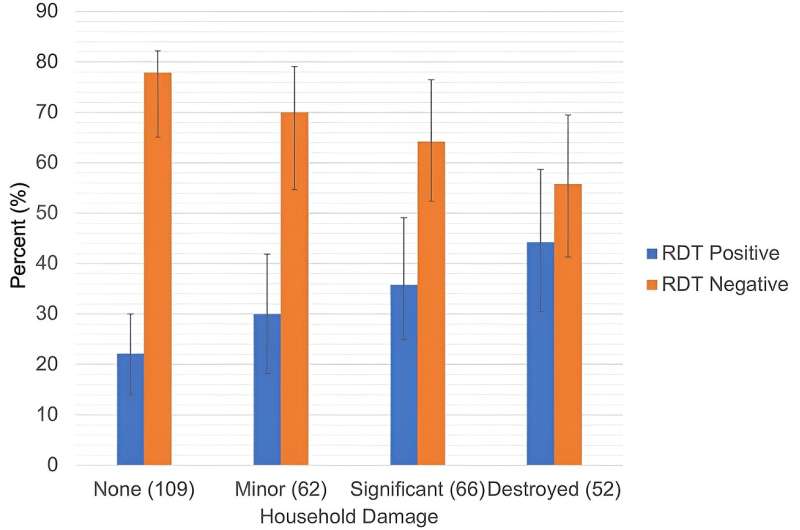This article has been reviewed according to Science X's editorial process and policies. Editors have highlighted the following attributes while ensuring the content's credibility:
fact-checked
peer-reviewed publication
trusted source
proofread
Storm damage to residences linked to higher malaria prevalence in Mozambique

Though malaria has been eliminated in several countries, the mosquito-borne disease remains a major public health concern in sub-Saharan Africa. Mozambique has the fourth-highest prevalence of malaria in the region and is vulnerable due to a range of factors, including inadequate health care infrastructure, limited access to prevention measures, and climatic conditions conducive to mosquito breeding.
A new study from the University of Minnesota School of Public Health (SPH), published in Nature, adds another factor to the mix: residential structure damage from severe weather.
Malaria transmission is highly dependent on weather and climate-related factors—mosquitoes reproduce in higher numbers in wetter, warmer weather. Countries like Mozambique are seeing firsthand the impact of global climate change on local weather conditions. Over the past 35 years, Mozambique has experienced more than 75 declared natural disasters related to floods, droughts, and cyclones.
In 2019, Cyclone Idai—one of the worst tropical cyclones ever recorded in the Southern Hemisphere—caused catastrophic damage to people, buildings and infrastructure across Mozambique. Poor housing conditions can increase interactions with mosquitoes, leading to heightened malaria risk in the immediate and long term, as well as hampering the efficacy of disease control efforts.
The researchers sought to quantify the malaria risk associated with household damage caused by Cyclone Idai. They conducted a survey in Sussundenga, a rural agrarian village located in western Mozambique, and found that nearly one year after the storm:
- 64% of study participants lived in households that sustained damage during Cyclone Idai.
- The overall malaria prevalence was 31%.
- The odds of malaria infection was nearly three times higher among participants who lived in damaged households.
- Malaria prevalence increased with increasing levels of household damage. Malaria prevalence was higher in households with significant damage (35.8%) or complete destruction (44.2%) compared to households with no damage (22.1%).
"Previous studies used simulations and prediction models to explore the impact climate change has on malaria risk," says Kelly Searle, SPH assistant professor and lead author.
"By using real-world observations, this study is among the first to conclusively demonstrate the associations between climate change, severe weather, and increased prevalence of malaria."
"We found participants whose households were damaged by Cyclone Idai had a nearly threefold increase in malaria infections compared to those who did not experience household damage in an area of already high malaria incidence. Since our data was collected nearly a year after Cyclone Idai, this is a substantial concern."
The study also calls attention to the need for more effective long-term disaster response efforts, citing the fact that only one household interviewed by researchers reported receiving any assistance from response organizations in the aftermath of Cyclone Idai.
More information: Kelly M. Searle et al, Long-lasting household damage from Cyclone Idai increases malaria risk in rural western Mozambique, Scientific Reports (2023). DOI: 10.1038/s41598-023-49200-3





















